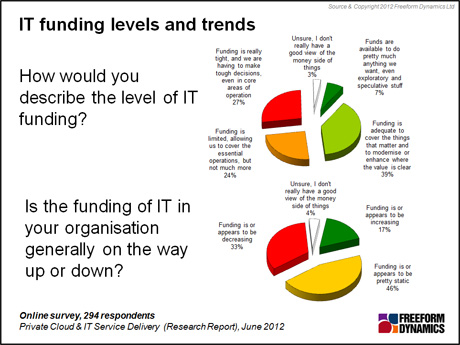The impacts on budgets, reporting and IT delivery models.
When economic times are hard there is always pressure on budgets in every area of business operations. Indeed justifying any spend at all has become subject to ever more intense scrutiny and in IT this has been reflected by vendors proclaiming IT budgets are being ‘slashed’ and that IT must ‘do more with less’.
In a recent online survey we asked IT professionals how budgets are changing inside their organisations. Whilst the report of the results from the survey does record that IT funding is under stress in many organisations, it should be remembered that this is the case across the board in business as a whole – i.e. there is nothing unique about the IT department compared to other areas of the business. But there are signs that IT spending is far from being slashed to the bone.

Figure 1
As can be seen in Figure 1, significant numbers of respondents state their IT budgets are at a level that allows them to do everything they have to do. Perhaps of even greater importance, many report they also still find it possible to get investment in new IT projects. Perhaps unsurprisingly, this is reflected mostly by organisations where IT and businesses communicate well together and in which IT service delivery is visibly well aligned with the needs of the business. Naturally, even here, new IT project proposals must lay out a clear business case in a form that business stakeholders can understand.
One potential response to the financial challenges facing IT could be the adoption of technology aimed at streamlining the IT delivery process, boosting physical infrastructure asset utilisation, and generally lowering overheads, and it’s based on these promises that a number of key vendors are promoting, Private Cloud. But how do the claims translate to reality, and is it only just about efficiency?
Well there must be something real and valuable here, because according to the research, many IT professionals already recognise the adoption of Private Cloud solutions as a logical next step forwards from existing and planned virtualisation projects, so let’s drill into what’s on offer a little deeper, and where it fits into the greater scheme of things.
Private Cloud systems depend upon the sharing of computing resources amongst multiple IT services combined with the notion that such resources can be rapidly adjusted to ensure users obtain the levels of service quality they require to do their jobs. Indeed, the combination of active management and shared resources are major factors that transform a standard virtualised infrastructure into a Private Cloud. But moving towards the large scale use of Private Cloud poses a range of technical, process and financial challenges that it’s important to be aware of.
Of these the most straightforward to address concerns the requirement for new tools that enable management and administration of the combined server, storage, networking and application resources in a seamless manor. That said, we know from many surveys carried out by Freeform Dynamics over the years that getting budgets to pay for new management tools can take considerable time and effort.
As well as pulling things together across previously separate domains, Private Clouds, by their very nature, are also designed to be dynamically managed to ensure each IT service receives the resources needed to deliver specified levels of service as circumstances and usage vary. This will in turn necessitate using tools to monitor the service levels delivered, even including user experience. It will also become desirable, if not a necessity, to report to business users on the service levels being delivered, if only to ensure that everyone is aware that they are not being disadvantaged by the sharing of resources with other business units.
Beyond tooling, keeping a Private Cloud functioning smoothly typically also requires IT departments to modify, perhaps drastically, many of the operational procedures and processes in place today. For some organisations this may well mean taking steps to combine different teams, for example the storage, server and networking groups, into new units combining all the skill sets.
All of these IT related matters are then likely to have a considerable impact on the way in which IT budgets are funded. Today many organisations still pay for ‘IT Infrastructure’ out of individual project requirements, rather than investing in the infrastructure itself. These existing budgetary models are not suited to working effecting with dynamically shared resources. The time for the active use of ‘charge back’, or at least ‘show back’, for the use of IT resources may become a requirement if user disputes are to be avoided.
Even if IT funding and accounting do migrate towards some form of activity or usage based model, the business may have to face an even tougher challenge. Private Clouds can react very quickly to changing demands and move resources around to keep service levels at a desired quality, but they do not offer infinite capacity.
Until organisations find ways of adding capacity on the fly, perhaps utilising external cloud services, there may be times when the availability of physical resources is stretched. At such points, someone will need to decide which IT services receive the capacity available and which services will have to accept reduced quality for a period of time. Then for persistent growth situations, alternative budgets will need to be found, very rapidly, to pay for service enhancements.
Clearly, IT does not want to be put in a position to have to make such choices without senior business managers being involved, so a key question for IT leaders is: Are you ready for Private Cloud?
CLICK HERE TO VIEW ORIGINAL PUBLISHED ON
